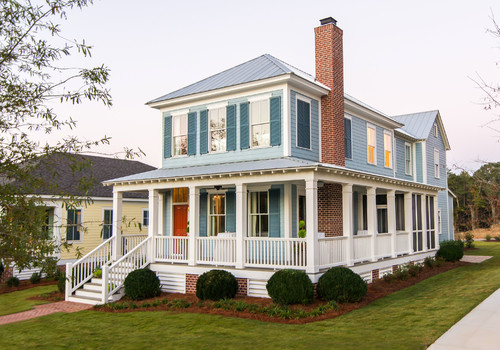I do not think you can see an old building without the classic chimney. Generally, chimneys are specific of the houses built in the late nineteenth and early twentieth century. In fact, at that time wood-burning stoves were the only source of heating. But not only. Even later, since the mid-twentieth century, when it switched from wood burning to coal and oil burning, a chimney was necessary for the hot gases and smoke to leave house.

Photo by Our Town Plans – Look for exterior home design inspiration
Of course, nothing compares to the ambiance of wood burning stove. They can keep you warm in the winter but can also present risks to your health. They can be also, a fire hazard. In fact, proper installation and maintenance of your stove and chimney are the best protection against a fire.
A good chimney depends on several factors such as:
1. Stonemason craftsmanship
2. The type and the quality of mortar
3. The chimney flue
Let’s see some tips to make your brick chimney safe.
Materials & Tools
- Mortar; Mortar Bag; Chimney Liner Kit;
- Measuring Tape; Bucket; Tin Snips; Screw Driver;
- Ladder; Trowel; Jointer Tool;
Steps:
Step 1: Chimney Inspection
Start with an inspection of your brick chimney. To do this, you need to get on the roof of your home. Climb the ladder to the roof.
Caution: Make sure the ladder is stable and safe before using it.
Check your chimney. The most important is to check the mortar that binds bricks together. Look for cracks or missing mortar pieces.
If the exterior of your chimney is damaged then there are good chances that the inside of the chimney to be also affected.
Advantages and Disadvantages of Slate Roofs (howtobuildahouseblog.com)
Step 2: Fill the Joints with Mortar
Stir the mortar with water in a bucket, to get a thick consistency.
Use a mortar bag to squeeze your thick composition into the joints, between the brick rows.
Use a trowel to smooth the joints.
Allow three days for mortar to dry, and only after that, you can use your chimney.
Step 3: Check on the Chimney Flue Liner
Usually, the chimney flue liner is in the form of a fireclay liner (5/8-inch thick with 1/2-inch gap).
Use a flashlight and examine the chimney flue, both from inside the house and from the house roof.
If the chimney flue looks, solid (a liner made of metal) then you can use your wood burning stove. However, if you notice any cracks in the flue liner, then you should reline your chimney, and only after that, you can use it.
Step 4: Add a New Metal Liner
Adding a new metal chimney liner will increase the chimney and stove safety. Hot gases will leave your home without any leakage risk.
How to proceed:
Use the “Chimney Liner Kit”.
1. First, using tin snips you should cut a length of liner the same length as the chimney height.
2. Use a insulation layer to cover your liner and then coat it with a wire mesh.
3. The next step is dropping the liner inside of the chimney.
4. Secure the top of the liner with a top plate and clams. In fact, you have all the instruction in your “Chimney Liner Kit”.
5. Use a metal cap for the chimney liner top. This metal cap will protect your chimney from birds. It does not allow birds making their nests on top of the chimney.
6. The last step is the installation of the wood burning stove.


